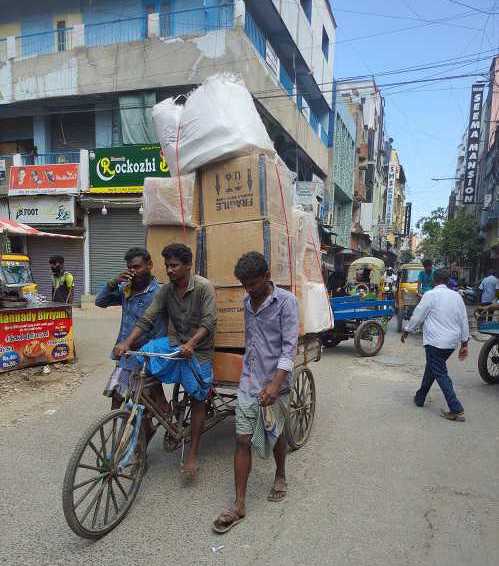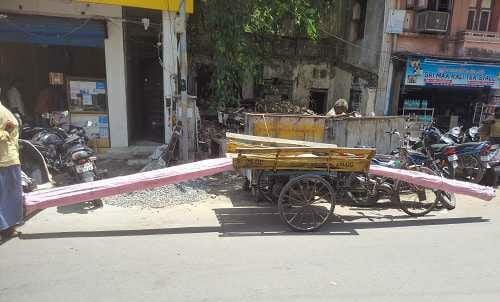George Town in Chennai encompasses NSC Bose Road and many bylanes that bustle with activity at all times. It is a wholesale market where businesses and individuals buy goods in bulk for cheap. The narrow lanes and many shops make navigation of these roads very difficult. While much has changed about the area over the years, the tricycle carts used by cart pullers to transport goods have remained constant.
In the din, from dawn to dusk, one can spot men on their tricycles, moving goods to and from the market. They work close to 12-14 hours a day. The cart used by these workers to carry materials within and outside the market area is a tricycle popularly called “Meen Body Vandi”.
The vehicle is called so because, in the past, it was primarily used to transport fish. Over time, it has become the conventional means to transport items in George Town.
Motorised versions of these carts have been banned by an order of the Madras High Court on account of them being unregulated, without a licence, insurance or registration. The tricycles have continued to exist despite the job taking a heavy toll on the physical health of the workers and the poor wages that they contend with.
Read more: Will the Urban Employment Scheme in Chennai end the woes of urban poor?
Many decades of transporting goods in carts
There are no precise estimates for the number of such vehicles in this area. It is bound to run into the hundreds. There are no dedicated stands for parking. The workers mostly own their vehicles and in some cases, the vehicles are hired by casual workers on a daily basis.
An informal survey with 72 such workers yielded many insights into their work and life.
Most of the workers were catapulted to this profession in their teens due to family circumstances and have carried it forward till now. Every person surveyed has been engaged in this work for the past 25 years or more. The oldest worker was 88 and has been plying these vehicles since the age of 18. The majority of the workers are aged between 50 to 65 with over 30 years of experience transporting materials on tricycle carts.
The majority of the workers start their day with the opening of shops and establishments in the area. The quantum of work for the day is not defined and they are at the mercy of the weather and the briskness of business in the market.
Sometimes they wait for work for long hours, only to chance upon a task that needed to be done close to the end of the day. The workers are informally connected with suppliers and transport companies who call on them whenever there is cargo to be moved. The distance between the collection point to delivery point can be within the bazaar area or faraway places within Chennai limits.
Irrespective of the distance, they are ready to accept every call. On days when there is a lull in business, they spend many hours waiting for the next job.
Earnings from pulling carts
Earnings are directly proportional to the work. A sudden glut in orders for the seller will get the workers a full day’s work. But there are times when they are engaged only for a part of the day.
The average earning for every worker interviewed is around Rs 600 per day. The maximum they can earn is Rs 1000. Only a couple of workers have had days where they could earn up to Rs 1200. The earnings include the loading of materials onto their cart, transportation and unloading thus resulting in heavy labour. The merge returns give them hand-to-mouth living. The annual repairs to the vehicle would cost them around Rs 6000.
When COVID lockdown brought their livelihood to a standstill, many resorted to borrowing to meet their needs as their earnings plummeted. The borrowed money is being paid back now in instalments.
Earnings are received in cash instantly. Though all workers have a cellphone, very few use them for digital transactions.
Convenience and constraints
Depending upon the business activity, every worker rides anywhere from a minimum of 6 kms to a maximum of 30 kms per day. Deliveries at faraway places like Mylapore and Tondiarpet are invariably taken up in the second half of the day. There is a risk to owners in this means of transport. Any damage to materials during transport is not covered by insurance.
The workers are aware of this and are relied upon by businesses as they have been known to deliver without any damage to the goods. Business owners prefer this means of transport for its flexibility and low cost.
When asked whether they would be inclined to change their tricycle carts to electric vehicles similar to the ones used in conservancy work, some of the workers expressed willingness. Others hesitated on account of their financial inability to buy such a vehicle. Workers who transport long pipes and steel materials did not favour switching to electric vehicles as they are not compatible with the materials transported by them.
Offering incentives for the workers to migrate to the electric vehicle would help. The present vehicle, while not being a non-emitter of Green House Gases, takes a toll on the physical health of the workers.
Read more: Chennai’s garment workers forever exploited, as watchdog looks the other way
Impact of pulling carts on health of workers
Pedalling long distances every day has a telling effect on their health. More than half of the workers complained of knee, calf or leg pain. Many also suffer from diabetes. A few of the workers suffer from heart ailments. They do not have access to advanced medical care and are compelled to accept the available treatment at the nearest government hospital at the designated time.
The older workers complained of blurry vision after sunset. This forces them to retire for the day earlier than their younger counterparts. With bodily aches having become chronic and no medical care, many of those interviewed candidly admitted that they seek relief in the intake of liquor at night.
“It is the liquor which relieves us of leg pain and prepares us for the next day’s work. After all that is what we want. Nothing more, nothing less” says a 67-year-old worker who has been working for 40 years and has developed an addiction to alcohol.
What can help
Many of the workers stated that their hard work was able to help provide a reasonably good education to their children. Some of their children have completed an undergraduate degree and are gainfully employed. Yet, the workers continue their job as they do not wish to be idle at home.
What can help improve their working conditions are a few actions on the part of the government.
Keeping all the lanes in the area clean, by removing garbage multiple times during the day, would aid workers in navigating these busy streets. The number of hygienic urinals and public toilets in the area has to also be increased.
Health camps need to be conducted periodically and such manual workers should be made aware of the various schemes such as the Chief Minister’s Comprehensive Health Insurance Scheme under which they may be able to get some benefits. This will help them seek solutions for the physical toll taken by the job and move away from dependence on alcohol.



It would be a better alternative to convert these into EV or E rickshaw. The Manual effort is avoided and it will supplement their income as faster trips are possible. I am willing to co ordinate, need to speak to the Author
Pl contact me on 9789016371